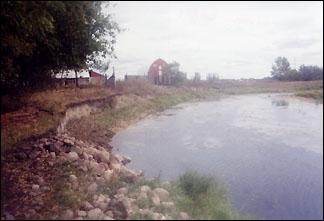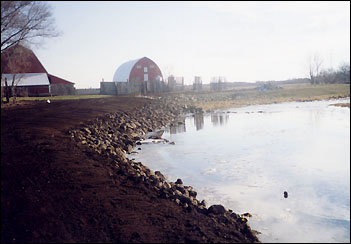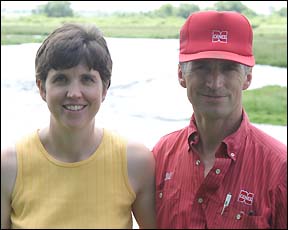Crow River project completed on Hoeft farm
 During a rain event, according to Rick Reimers of the Kandiyohi County Soil and Water District, their river bank could lose 18 tons of soil, enough to nearly fill two trucks.
During a rain event, according to Rick Reimers of the Kandiyohi County Soil and Water District, their river bank could lose 18 tons of soil, enough to nearly fill two trucks.
Before the project, the Crow River ran straight into a bank on the Hoeft farm before making an S-curve. The current dug into the bank wherever the river flooded, and the Hoeft's could lose 18 tons of soil during a rain event.
Last fall, the Hoefts had their riverbank repaired, building a new bank and altering the flow of the river to prevent soil erosion.
The project involved 330 feet of riverbank on the Hoefts' farm four miles west of Paynesville, just over the Stearns/Kandiyohi border in Roseville Township. The project - designed and overseen by Reimers, with proper permitting from the DNR - involved building spur dikes, reconstructing the riverbank, and planting vegetation on the new bank, including 15 varieties of wild flowers, to stabilize the soil.
The four spur dikes, strings of large rocks, push the main flow of water into the center of the river channel. The main flow used to run straight into the Hoefts' riverbank before making an S-curve around their barn and barnyard.
 The spur dikes move the energy to the center, where it does not erode the riverbank. "We've taken the energy of the river and taken it to the center of the river, where it should be," said Reimers.
The spur dikes move the energy to the center, where it does not erode the riverbank. "We've taken the energy of the river and taken it to the center of the river, where it should be," said Reimers.
The river bank was rebuilt last fall with rocks, trees, and native vegetation.
The project - which took two years to plan but only ten days to construct in October and November 2003 - also included burying rocks and logs into the new bank, with roots exposed for fish habitat.
Last fall was a good time to do the project since the drought left low water in the Crow River, allowing the contractor to complete the work. Bill Hoeft's father purchased the 200-acre farm in 1969, and Bill bought the farm from his father in 1990. A willow tree used to stand on the bank right where the river curved and it absorbed much of the energy of the water, according to Hoeft, and its root structure helped to hold the bank in place.
But when that willow tree died six to eight years ago, the water started digging into the bank, said Hoeft. Once it started digging into the soil, it continued.
The river eroded the bank, said Reimers, "until it became a five-foot vertical bank."
Soil sediment is a major detriment to water quality, according to Reimers, plus the bank is more stable, and the Hoefts continual loss of land will stop. That land loss had threatened a fence around the Hoeft's barn, as the eroding bank encroached on the barnyard.
 "That bank just crept closer and closer," said Hoeft.
"That bank just crept closer and closer," said Hoeft.
The river project was needed, according to Hoeft, because "if you didn't do anything it would just get worse and worse."
Nancy and Bill Hoeft are pleased with their river bank project so far. The Crow River meanders through their farm for three-quarters of a mile.
While erosion of the riverbank was not such a problem when the river was low, it becomes one when the river flooded, said Hoeft. Less storage of water upstream in the watershed means greater water volumes in the river. "You don't have to have much of a rain, and the river comes out of its banks," said Hoeft.
"The river comes up faster and stays up longer than it did years ago," he added. In fact, it doesn't even need to rain in the Paynesville area for the river to flood. Just getting rain upstream in the watershed is enough for the river to flood.
In addition, the bridge over Co. Rd. 6, just east of the Hoefts' property, is smaller than the upstream bridges, meaning more water flows down the river than can pass under that bridge, causing the river to flood on their farm, said Hoeft.
The project cost $25,000 to complete, with grants from the Board of Water and Soil Resources (BWSR), the Kandiyohi County Water Plan, and from the Rice Lake Association and the Koronis Lake Association helping to pay for it. The Hoefts contributed in-kind work and out-of-pocket costs, for instance for new fencing. They also moved their pasture fencing and made a new corridor for their cows to get to the river. Hoeft had previously worked with the Kandiyohi County Soil and Water District to build a manure pit in the 1990s. He also has 35 acres of land enrolled in the Conservation Reserve Program (CRP) and has planted over 1,000 trees on his property for habitat, windbreaks, and natural snow fences.
Hoeft hopes the river project works as planned. "So far," he said, "So good."
The North Fork of the Crow River meanders through the northeast corner of Kandiyohi County for approximately six miles before going through the city of Paynesville and then Rice Lake and Lake Koronis. The river runs through the Hoefts' property for about three quarters of a mile.
According to Reimers, the Hoefts' riverbank project is the first soil erosion project on the Crow River in Kandiyohi County.
Contact the author at editor@paynesvillepress.com • Return to News Menu
Home | Marketplace | Community